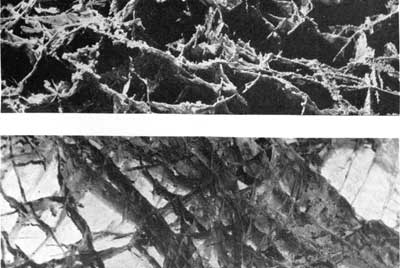![]()
MENU
![]() Wind Cave
Wind Cave
|
Glimpses of Our National Parks
THE WIND CAVE NATIONAL PARK SOUTH DAKOTA Special Characteristics: Limestone Cave With Unusual Boxwork Formations |
 Characteristic boxwork formations not found elsewhere in the United States—Wind Cave National Park |
THE southwestern corner of South Dakota, in which Wind Cave National Park is located, has a fascinating story of earth-making to tell. It ranges from ancient fossil deposits buried in the Badlands telling a tale of prehistoric alligators, rhinoceroses, three-toed horses, and other long extinct animals, to the lofty, needlelike formations that erosion has sculptured of granite high up the forest-clad slopes of the Black Hills.
Wind Cave lies in the great Pahasapa limestone formation which also contains several other large subterranean caverns. The facts about the discovery of the cave are little known, but it is generally believed that it was discovered by Tom Bingham, a Black Hills pioneer, while hunting deer in 1881. He was attracted by a strange whistling and after searching about in the undergrowth, he discovered that it was caused by wind escaping through a small hole in some rocks. This hole, not more than 10 inches in diameter, is the only natural opening to the cave so far discovered.
The strong currents of wind that blow alternately in and out of the mouth of the cave suggested its name. This strange phenomenon is believed to be caused by changes in the atmospheric pressure outside. When the barometer falls the wind blows outward; when it rises, the wind blows in.
The present opening was made by digging down about 6 feet to the first of a series of corridors and galleries decorated with a variety of crystal forms.
There are very few stalagmites and stalactites, the most beautiful of the cave deposits being of the type known as "boxwork." It is composed of delicate veins of calcite deposited in cracks in the limestone. The surrounding rock, more easily dissolved than the veins, has been carried away, leaving the vein deposits projecting from the surface. Exquisite tiny crystals of aragonite (a form of calcium carbonate) are also present in certain parts of time cave.
WILDLIFE ABUNDANT
The surface area of Wind Cave National Park furnishes one of the best examples of the undisturbed wildlife on our western plains. Surrounded by a high fence, its 12,000-acre range supports over 200 bison, about 50 antelopes or pronghorns, about the same number of mule deer and 150 wapiti or elk. The motorists may see the buffalo herd and at least a few antelope grazing peacefully on the rolling hills. Wapiti can be seen only at dusk or early in the morning when they come out of the yellow pine woods to graze. There are numerous small animals. Prairie dogs enjoy life in several "towns" just as they did before the white man arrived and started extensive poisoning campaigns because of interference with agricultural pursuits. Once in a while a coyote is seen. In spite of the comparatively small area and uniformity of conditions there is a surprisingly wide variety of bird life. Hawks are abundant and other characteristic plains birds are the western meadowlark, horned lark, white-rumped shrike, western nighthawk and dickcissel.
|
|
Last Modified: Fri, Sep 1 2000 07:08:48 pm PDT
glimpses1/glimpses9.htm

 IX
IX

 Top
Top